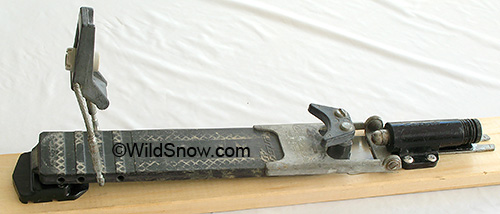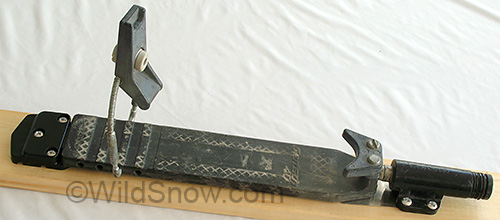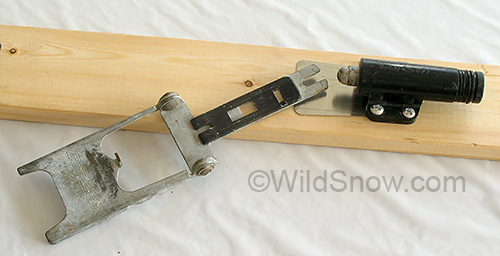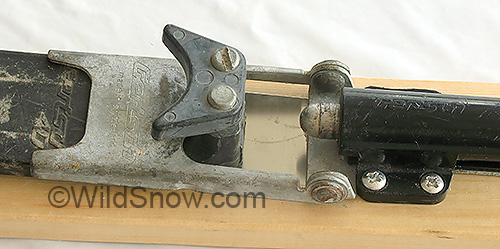This ingenious ski touring adaptation of an alpine binding has no equal in the history of AT ski touring bindings. Gertsch was a well known Swiss plate binding in the 1970s, and their piston/spring release mechanism design is still in use for release telemark bindings. With the addition of a bracket and pivot, the binding converted to a touring rig. Whoever thought this up deserves an award. It was popular for a while with Canadian heli-ski guides who needed an alpine binding they could tour with on occasion. Problem was the binding did not work well as an alpine binding, it was prone to accidental release unless skied at high release value settings.
We do not have firm dates for this item. Some say it was available from around 1975 to 1982, but it might have been an earlier date range than that. We’ll keep the dates of 1971 – 1975 in the title for now.

Complete Gertsch binding with adapter installed shown above. Binding is in tour mode.

Above binding is shown without touring adapter, in downhill alpine mode.
Lateral (side) safety release is accomplished by the front of the plate sliding to the side off the spring loaded piston. Vertical release is a function of the rear of the plate pulling up from a tapered slot as the piston in the front compresses. I once used this binding in alpine mode, and found that having no independent adjustments for side and vertical release made it difficult to adjust the binding to a safe release tension yet avoid accidental release.

Adapter is installed by sliding the tongue through a tunnel under the binding toe unit.
The adapter appears vulnerable to sliding back out during uphill skinning, so one assumes it had some sort of catch that prevented this.

Binding shown above with adapter installed.
Once the boot is latched in it holds everything together. One downside of this binding is that it locates your foot some distance back from the pivot while in touring mode, resulting in an unnatural stride. Check out our video for clarification of how the whole thing works.
According to some accounts, Fritschi ski touring bindings originated from the Gertsch (though we are not clear during which date range this occurred). The story is that Gertsch jobbed out their parts manufacturing to a Swiss company, Fritschi, that made precision drawing tables. This prompted Fritschi to enter the ski binding business themselves using ideas they’d developed while producing the Gertsch. Examination of Fritschi’s first binding, the FT88 (circa 1982), reveals many similarities between it and the earlier Gertsch, thus this story is likely fact. (source: Alpenglow.org ). As for the name, it is said to come from the binding’s designer Rudi Gertsch.
Weight (one binding with screws and adapter): 28.5 oz, 806 gr
Weight (one binding with screws, without adapter): 21.5 oz, 608 gr
Weight of touring adapter: 7 oz, 198 gr
Thanks goes to Tony Thompson for donating these bindings to the museum.

Gertsch thumbnail.
